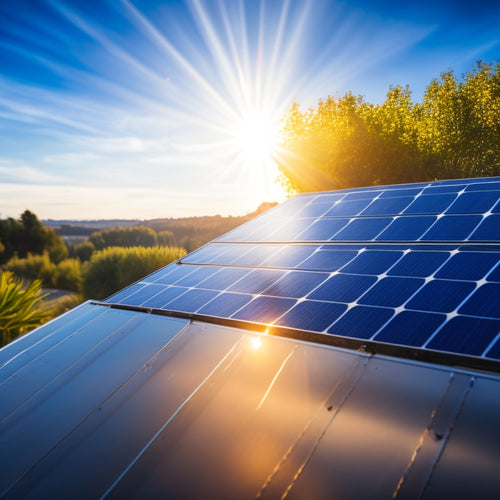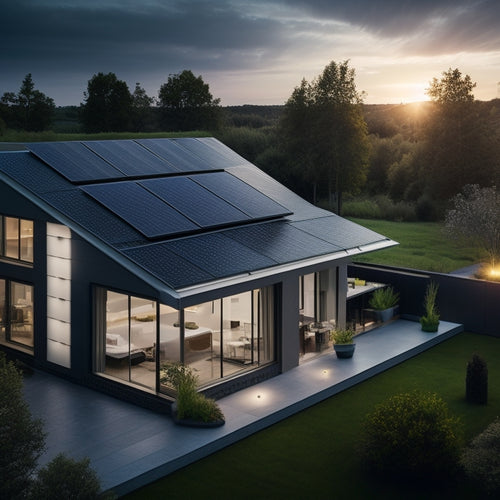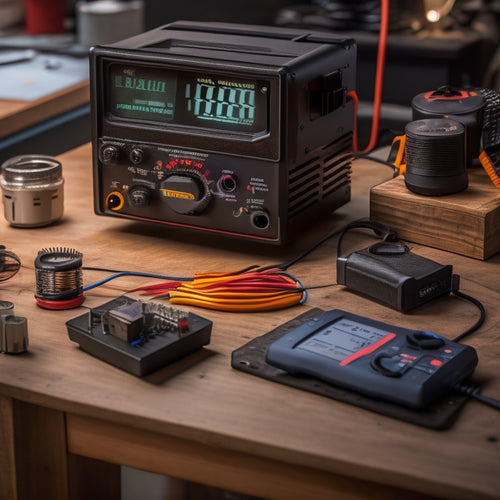
Emergency Backup Solar Power System
Share
You're investing in an emergency backup solar power system to guarantee your essential appliances remain operational during grid outages, providing safety and comfort when you need it most. This system seamlessly shifts to backup power, accommodating power availability during both daytime and nighttime outages. By combining high-performance batteries with solar panel efficiency, you can enjoy an uninterrupted power supply. To achieve energy self-sufficiency, it's vital to assess your energy demands, identifying essential appliances and devices needed during power outages. As you investigate the world of emergency backup solar power systems, you'll uncover the importance of deep cycle battery technology, longer power backup times, and more – all significant components of a reliable and sustainable solution.
The Essentials
- Emergency backup solar power systems provide reliable power during grid outages, ensuring essential appliances remain operational for safety and comfort.
- A seamless transition to backup power is facilitated by high-quality solar panel installations, accommodating power availability during both daytime and nighttime outages.
- Investing in solar systems enhances emergency preparedness, allowing for reliable power during extended outages and reducing reliance on the grid.
- Advanced inverter technology ensures seamless switching during outages, contributing to system reliability and grid-independent operation.
- Accurate assessment of energy demands is critical for designing a reliable backup power supply, considering essential appliances, daily energy usage, and backup duration.
Reliable Power During Outages
When the grid goes down, you need a reliable source of power to keep your essential systems running.
That's where a well-designed emergency backup solar power system comes in, providing you with power when you need it most.
With a Solar Power Backup system, you can avoid the hassle of refueling noisy generators and reduce your reliance on them Reliable Electricity Supply.
Power When You Need
A reliable emergency backup solar power system provides you with power during outages, ensuring your essential appliances and devices remain operational. This is vital for your emergency preparedness, as it guarantees you'll have the necessary power to stay safe and comfortable during extended grid outages. With a well-designed solar panel installation, you can rest assured that your backup system will kick in seamlessly, providing you with the power you need, when you need it.
| Scenario | Grid Power | Backup Solar Power |
|---|---|---|
| Daytime Outage | No Power | Power Available |
| Nighttime Outage | No Power | Power Available (with battery backup) |
| Extended Outage | No Power | Power Available (with battery backup and solar recharge) |
In each of these scenarios, a reliable emergency backup solar power system provides you with the power you need to stay safe and comfortable. By investing in a high-quality solar panel installation and backup system, you're taking an important step in your emergency preparedness, ensuring you're always ready for whatever life throws your way.
Grid Independent Operation
During extended grid outages, your emergency backup solar power system takes center stage, providing you with reliable power and independence from the grid. This is where the off-grid lifestyle you've been aiming for becomes a reality.
With a well-designed system, you can enjoy uninterrupted power supply, even when the grid is down. A high-performance battery for off-grid solar systems, such as deep cycle power storage options Renewable Energy Storage, can alleviate concerns of inconsistent power supply and premature battery degradation.
Your solar panel efficiency plays a significant role in this setup. High-efficiency panels guarantee that you're generating maximum power from the available sunlight, which is then stored in your battery bank for later use. This means you can power your essential appliances, lighting, and communication devices without relying on the grid.
In grid-independent operation, your system automatically switches to backup mode during an outage, guaranteeing a seamless shift. This is made possible by advanced inverter technology that constantly monitors the grid and takes control when necessary.
With a reliable emergency backup solar power system, you can rest assured that you'll always have power when you need it, no matter what the grid is doing.
Renewable Energy Independence
You're now considering renewable energy independence, which means exploring energy self-sufficiency options that reduce your reliance on the grid.
With a well-designed emergency backup solar power system, you can enjoy green energy freedom now, leveraging the power of solar energy to fuel your daily needs.
Complete off-grid solar panel system kits can provide a reliable source of energy for rural homes, RVs, and remote locations off grid solar panel kits.
Energy Self-Sufficiency Options
As the world shifts towards a more sustainable future, renewable energy independence becomes an increasingly attractive option for those seeking to reduce their reliance on the grid.
You're likely considering energy self-sufficiency options that align with your values of sustainable living. Solar energy solutions can play a significant role in achieving this goal.
One approach is to invest in a hybrid system that combines solar power with energy storage. This setup enables you to utilize solar energy during the day and store excess energy for use during the night or when the grid is down.
Another option is to integrate solar panels with a backup generator, providing a reliable source of power during extended outages.
When evaluating energy self-sufficiency options, consider your energy needs, budget, and available space for solar panels.
You may also want to investigate local incentives and policies supporting renewable energy adoption.
Green Energy Freedom Now
By breaking free from the grid, you can achieve green energy freedom now, enjoying the benefits of renewable energy independence. This means relying on sustainable living practices and energy conservation methods to reduce your reliance on non-renewable energy sources.
With a well-designed emergency backup solar power system, you can generate your own electricity and store excess energy for later use. This not only reduces your carbon footprint but also saves you money on your energy bills.
Here's a breakdown of the benefits of green energy freedom:
| Benefits | Description | Advantages |
|---|---|---|
| Energy Independence | Generate your own electricity | Reduce reliance on grid |
| Sustainable Living | Use renewable energy sources | Lower carbon footprint |
| Energy Conservation | Reduce energy consumption | Save money on bills |
| Increased Security | Have backup power during outages | Peace of mind during emergencies |
Deep Cycle Battery Technology
You'll want to take into account two critical aspects of deep cycle battery technology for your emergency backup solar power system: battery life expectancy and charging cycle efficiency.
These factors notably impact the overall performance and reliability of your system. When selecting deep cycle batteries, it's vital to take into account off-grid systems that can provide reliable backup power during outages, and also understand how the batteries will interact with your solar power system, including solar panels and inverters.
Battery Life Expectancy
Deep cycle batteries, a vital component of an emergency backup solar power system, have a life expectancy that largely depends on their quality, usage, and maintenance.
You should be aware that the lifespan of your batteries will vary depending on several factors, including the type and quality of the batteries, how often they're cycled, and how well you maintain them.
Proper battery maintenance is essential to extending their lifespan. This includes regular checks on the electrolyte levels, ensuring the terminals are clean, and keeping the batteries at ideal operating temperatures.
Lifespan factors such as depth of discharge, charge and discharge rates, and the number of cycles will also impact the overall life of your batteries.
By understanding these factors, you can take steps to maximize the life of your deep cycle batteries, ensuring your emergency backup solar power system remains reliable and efficient.
Charging Cycle Efficiency
When it comes to maximizing the life of your deep cycle batteries, understanding charging cycle efficiency is vital. This is because the charging cycle plays a significant role in determining how well your batteries perform and how long they last.
A charging cycle refers to the process of charging and discharging your batteries. The efficiency of this cycle depends on various factors, including the type of charging technology used, the depth of discharge, and the frequency of charging.
To optimize charging cycle efficiency, you need to guarantee that your charging technology is designed to work in harmony with your deep cycle batteries. This involves selecting a charger that can efficiently charge your batteries without overheating or overcharging them.
Efficiency optimization is important because it helps to reduce energy losses during charging, which can lead to premature battery failure. By optimizing your charging cycle, you can extend the life of your batteries, reduce maintenance costs, and guarantee a reliable backup power system.
With the right charging technology and efficiency optimization strategies, you can enjoy the freedom and security that comes with a reliable emergency backup solar power system.
Assess Your Energy Demands
You need to identify the essential appliances and devices you'll want to power during an outage, as this will determine the capacity of your emergency backup solar power system.
When it comes to renewable energy solutions, it's vital to evaluate your energy storage needs, such as home energy storage systems, to guarantee a reliable backup power supply.
Calculate your daily energy usage in watt-hours (Wh) to confirm your system can meet your needs.
Identify Energy Needs
To accurately design an emergency backup solar power system, evaluating your energy demands is crucial. You need to identify the devices and appliances that will be powered by the system during an outage.
Make a list of the essential loads, such as lights, refrigerators, and medical equipment. Consider the energy consumption of each device, including their wattage and usage patterns. For instance, do you need to power your refrigerator continuously or only during certain hours of the day?
You should also think about the devices that can be powered intermittently, such as computers and televisions. This will help you determine the total energy load required to support your needs during an emergency.
Additionally, consider the duration of the backup power required. Will you need power for a few hours, days, or weeks? By understanding your energy needs, you can size your solar power system correctly and guarantee it provides the necessary power during an emergency.
Calculate Daily Usage
Calculating daily usage is a critical step in evaluating energy demands, as it helps determine the total energy load required to support essential devices and appliances during an emergency.
To calculate your daily usage, you'll need to assess your energy consumption patterns. Start by tracking your energy usage over a period of time, using energy monitoring tools or your utility bills. Identify the devices and appliances you'll need to power during an emergency, such as refrigerators, lights, and medical equipment.
Next, determine the wattage and voltage requirements for each device. You can find this information on the manufacturer's label or in the user manual.
Multiply the wattage by the number of hours you expect to use each device per day to get the total watt-hours (Wh) required. Add up the total Wh for all devices to get your daily energy usage.
This calculation will help you determine the size of the solar power system you'll need to support your energy demands during an emergency.
Longer Power Backup Times
You can achieve longer power backup times by increasing your system's energy storage capacity.
This can be done by installing more solar panels or upgrading to higher-capacity batteries.
Extended Battery Capacity
A critical component of any emergency backup solar power system is its battery capacity, as it directly determines the length of time you can rely on the system during an outage.
You'll want to evaluate the type of batteries you use, as different battery types offer varying levels of energy storage. For example, lead-acid batteries are a cost-effective option but have lower energy density, while lithium-ion batteries provide more power per unit of weight and volume but come at a higher cost.
When selecting batteries, you should also assess their depth of discharge (DOD), which affects how much of the battery's capacity you can use before recharging. A higher DOD means you can tap into more of the battery's energy storage, giving you longer power backup times.
You'll also want to think about the overall battery configuration, including the number of batteries and how they're connected. A well-designed battery bank can provide the extended battery capacity you need to keep your essential appliances running during an extended outage.
Frequently Asked Questions
Can I Use My Existing Electrical Panel With the Backup System?
You're wondering if your existing electrical panel is compatible with a backup system. Generally, it's possible to integrate a backup system with your existing panel, but you'll need to verify the panel's capacity and configuration can handle the added power source.
How Long Does It Take to Install an Emergency Backup System?
"Rome wasn't built in a day," and neither is your backup system. You'll spend around 2-5 days on installation, depending on the complexity of the job, with a typical timeline of 1-2 weeks from permit to power-on.
Are Backup Solar Power Systems Noisy During Operation?
You'll find that some backup solar power systems can be noisy, but it depends on the inverter type; string inverters tend to hum, while microinverters and power optimizers typically operate quietly, keeping noise levels around 20-30 decibels, a gentle whisper.
Can I Expand My System if My Energy Needs Increase?
As you chart your energy independence, think of your system as a flexible puzzle: you can add more pieces (panels, inverters) and storage capacity as your energy needs evolve, ensuring your system scales seamlessly to meet your growing demands.
Are Emergency Backup Systems Susceptible to Cyber Attacks?
You're right to wonder: are backup systems vulnerable to cyber threats? Yes, they can be, if you don't implement strong cybersecurity measures to protect against system vulnerabilities, leaving your backup power susceptible to hacking and disruption.
Final Thoughts
You'll have reliable power during outages, renewable energy independence, and a sense of security. With a deep cycle battery technology, you'll bridge the gap between grid outages and restored power. By evaluating your energy demands, you'll tailor your system to your needs. And with longer power backup times, you'll weather any storm. You'll be self-sufficient, calm, and in control - a guiding light of hope when the lights go out.
Related Posts
-

How Efficient Are Thin Film Solar Cells
Thin film solar cells provide an innovative approach to energy generation, boasting efficiency rates generally betwee...
-

Home Solar Battery
You're opting for a home solar battery that allows you to utilize the power of the sun during the day and use it at n...
-

Key Features of a DC to AC Converter
A DC to AC converter features high efficiency and conversion rates, which reduce energy costs and improve performance...


